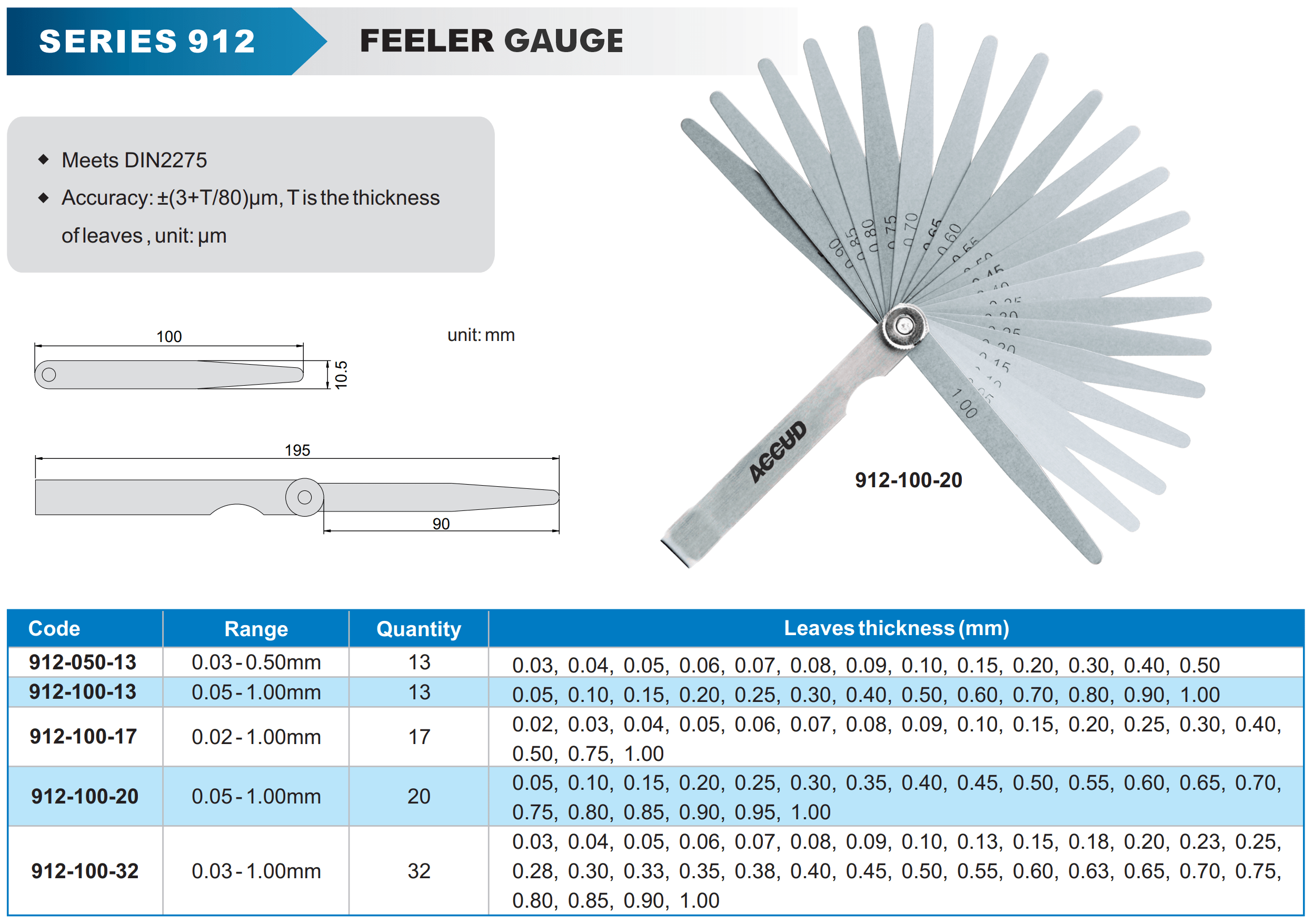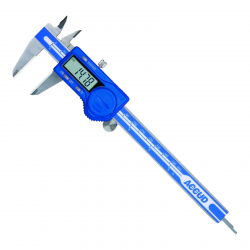
| Quantity | Unit Price | You Save |
|---|---|---|
| 5 or more | R 265.48 | 7.18 % |
| 10 or more | R 255.65 | 10.61 % |
| 20 or more | R 245.81 | 14.05 % |
- Stock: 7
- Model: AC912-100-32
- Weight: 0.12kg
- Dimensions: 109.00mm x 25.00mm x 25.00mm
- SKU: AC912-100-32
- UPC: 6009515866204
- MPN: 1
SERIES 912
Feeler Gauge, a precision tool used to measure gap widths or clearance between two parts, ensuring they fit or move together with the proper amount of space between them. This tool consists of a set of thin metal blades, each with a precise thickness, which can be used individually or in combination to measure small clearances in mechanical work, automotive repair, machining, and other precision tasks.
A feeler gauge is an essential tool for anyone involved in precision work, particularly in automotive repair, machining, and manufacturing. Its ability to accurately measure small gaps and clearances ensures that mechanical parts fit and function properly, reducing wear and improving performance. Compact, versatile, and precise, a feeler gauge is a must-have in any tool collection where accuracy is paramount.
- Meets DIN 2275 Standards
- Accuracy: ±(3+T/80)µm,
T is the thickness of leaves , unit: µm - Length closed: 100mm
- Length open: 195mm
- Leaf (blade) useable length: 90mm
Applications
-
Automotive Repair
- Valve Clearance: Used to measure and adjust the clearance between the valve tappet and the valve stem in an engine, ensuring proper engine performance.
- Spark Plugs: Used to check the gap between the electrodes of spark plugs, which is critical for proper ignition and engine efficiency.
- Brake Components: Can be used to measure the gap between brake pads and rotors or other components in the braking system.
-
Machining and Manufacturing
- Tool Setup: Used to set precise gaps between cutting tools and workpieces on lathes, milling machines, or other machining equipment.
- Bearing Clearance: Measures the clearance between bearings and their housings, ensuring proper fit and function.
- Surface Contact: Ensures that two surfaces are in proper contact with each other, or identifies the size of a gap that needs adjustment.
-
General Engineering
- Mechanical Assembly: Ensures proper spacing between parts in mechanical assemblies, reducing wear and ensuring smooth operation.
- Inspection and Quality Control: Used in quality control to verify that assembled parts have the correct clearance as specified by engineering designs.
-
Plumbing and HVAC
- Gasket Installation: Ensures that gaskets are properly seated with the correct compression and clearance.
- Pipe Fittings: Measures gaps in pipe fittings to ensure they are correctly aligned and sealed.
How to use
- Select the Correct Blade: Identify the appropriate blade or combination of blades that matches the gap you need to measure. Ensure the blade is clean and free from oil or debris before use.
- Insert Carefully: Gently insert the blade into the gap. If it slides in with slight resistance, you have the correct thickness. If it's too tight or too loose, try a different blade or combination.
- Stack Blades: If the exact thickness isn't available, combine multiple blades to achieve the desired measurement.
- Store Properly: After use, wipe the blades clean and store them properly to prevent damage or corrosion.
Key Features
-
Set of Thin Blades
- Varied Thickness: Each blade in a feeler gauge set is of a different thickness, usually measured in thousandths of an inch (imperial) or hundredths of a millimeter (metric).
- High Precision: The thickness of each blade is precisely manufactured, allowing for accurate measurement of small gaps or clearances.
- Material: The blades are typically made from high-quality steel, often stainless steel, to resist rust and maintain accuracy over time.
-
Blades are Foldable
- Compact Design: The blades are usually attached to a common holder or pivot point, allowing them to be folded out for use and then neatly stored back together, making the tool compact and easy to carry.
- Easy Selection: Users can select a single blade or a combination of blades to achieve the desired thickness for a specific measurement.
-
Combination Use
- Custom Thicknesses: Multiple blades can be stacked together to measure a clearance that matches the sum of their thicknesses, providing flexibility for a wide range of measurements.
- Markings: Each blade is clearly marked with its thickness, making it easy to identify and select the correct blade for the task.
Advantages
- Versatility: A feeler gauge can measure a wide range of gaps and clearances, making it a versatile tool in many mechanical, automotive, and industrial applications.
- High Precision: The accurate and consistent thickness of the blades allows for precise measurements, which is crucial in fine-tuning machinery and engines.
- Durability: Made from durable materials, a feeler gauge is designed to withstand frequent use and maintain its accuracy over time.
- Compact and Portable: The foldable design allows for easy storage and transport, making it convenient to carry around in a tool kit.
Technical Specifications











































































